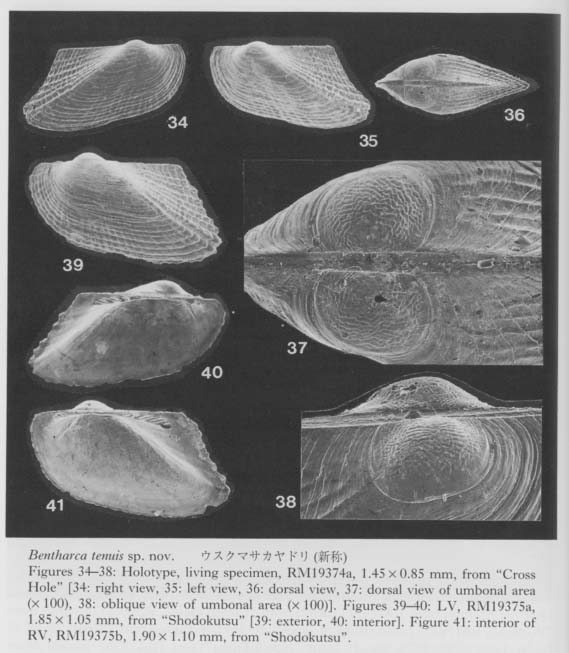Genus Bentharca Verrill and Bush, 1898
Bentharca tenuis sp. nov.
Figures 34-41

1992. Bentharca sp. B, Kase and Hayami,Jour. Moll. Studies, vol.58, p.448, listed.
Type and material.—Holotype: RM19374a, a living specimen from the bottom sediments of "Cross Hole" of Irabu Islet, Miyako Islands. Paratypes: RM 19366 (dead) from "Devil's Palace", RM19367 (dead) from "Fool's Palace", RM-19368 (dead) from "Witch's House", RM 19578 (living) from "Wall Cave", RM19369 (dead) from "Toriike", RM19370 (dead) from "Black Hole", RM19577 (dead) from "Coral Hole" of Shimoji Islet. RM19371 (dead) from "Lunch Hole", RM19372 (living) from "W-arch", RM 19373 (dead) from "L-arch", RM19374 (living) from "Cross Hole" of Irabu Islet. RM19375 (dead) from "Shodokutsu" and RM19567 (dead) from "Daidokutsu" of Ie Islet.
Diagnosis.—Very small, thin-shelled species of Bentharca, characterized by subtrapezoidal and roundly carinate outline, numerous radial ribs of variable prominence, shallow byssal indentation especially in early stage, relatively small number of hinge teeth, and large D-shaped Pd I with strong zig-zag ornament.
Description.—Shell scarcely exceeds 2.0 mm in length, thin, colorless and translucent, subtrapezoidal with not much reduced anterior part, about 1.7 times longer than high. Posterior margin slightly concave, forming an obtuse angle with dorsal. Ventral margin slightly concave in the middle part (especially distinct in early growth stage). Umbo nearly orthogyrous, incurved, situated about one-third of dorsal margin from anterior end. Flank broadly concave in the middle, with densely spaced commarginal lamellae and about 30 radial ribs of variable prominence, though early dissoconch is almost free of these sculptures. Posterior area depressed, with about seven prominent radial ribs. No marginal crenulations except for posterior periphery. Internal surface radially striated. Alivincular ligament persistent throughout growth. Cardinal area relatively narrow. Hinge plate only with about two prosoclinal anterior and three opisthoclinal posterior teeth. Pd I very large, D-shaped, with characteristic zigzag ornament, ranging 275-340 µm in maximum diameter; Pd II absent.
Remarks.—The present species attaches by byssus to the surface sediments, annelid tubes and cave walls. It differs from other cave arcids in the thinner shell, variably developed (generally weaker) radial ribs on the flank, and the huge and strongly ornamented Pd I. It resembles Bentharca xenophoricola Kuroda, 1930, from Japanese waters, especially the fossil specimens from the Shinzato Formation of Okinawa (Noda, 1980). However, the shell size is much smaller and the posterior carina is more prominent.
Distribution.—Common in many sublittoral caves of Ie and Shimoji-Irabu Islets of Ryukyu Islands. This species also occurs in "Balicasag cave" off Panglao Islet of Bohol Island, the Philippines.